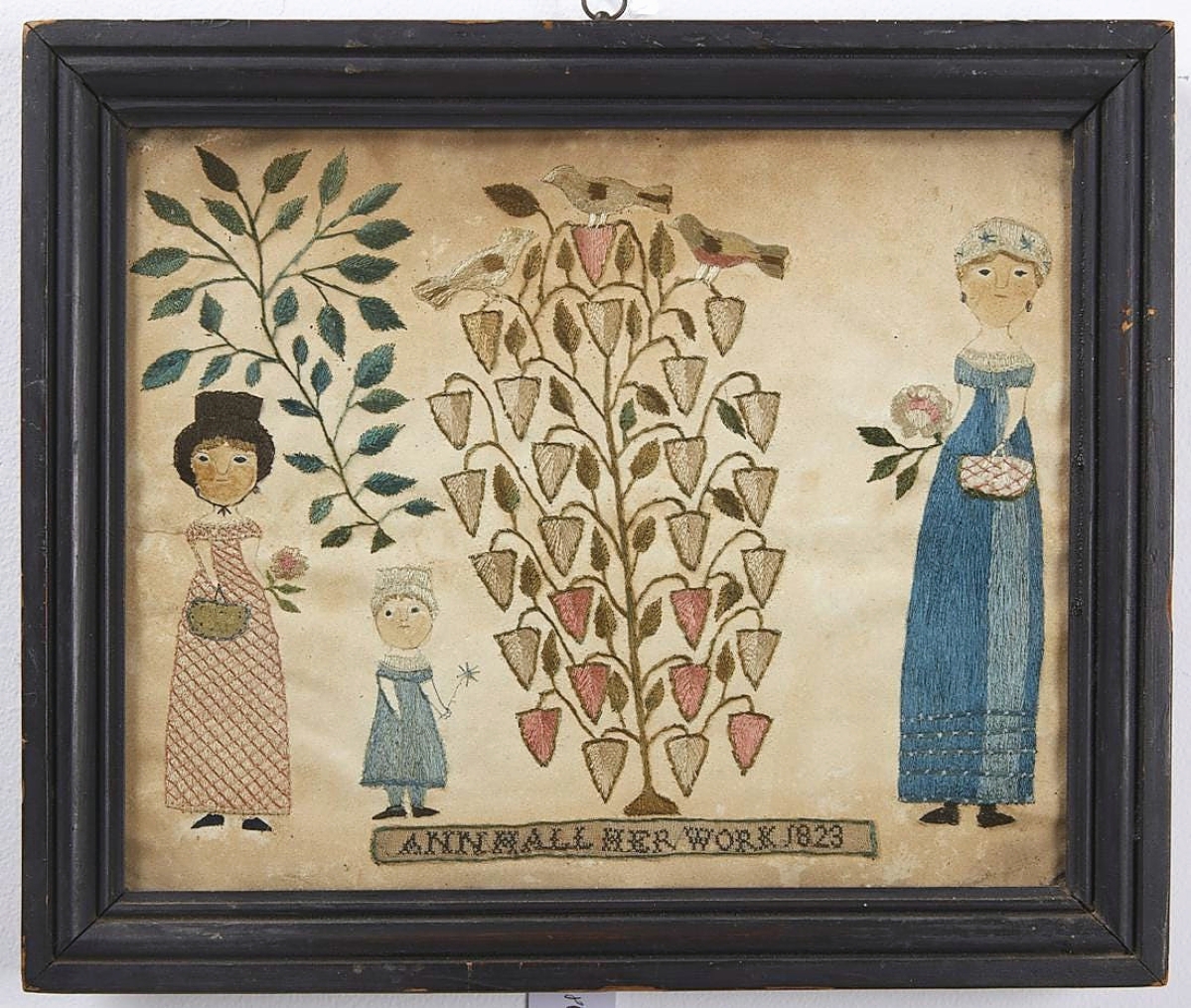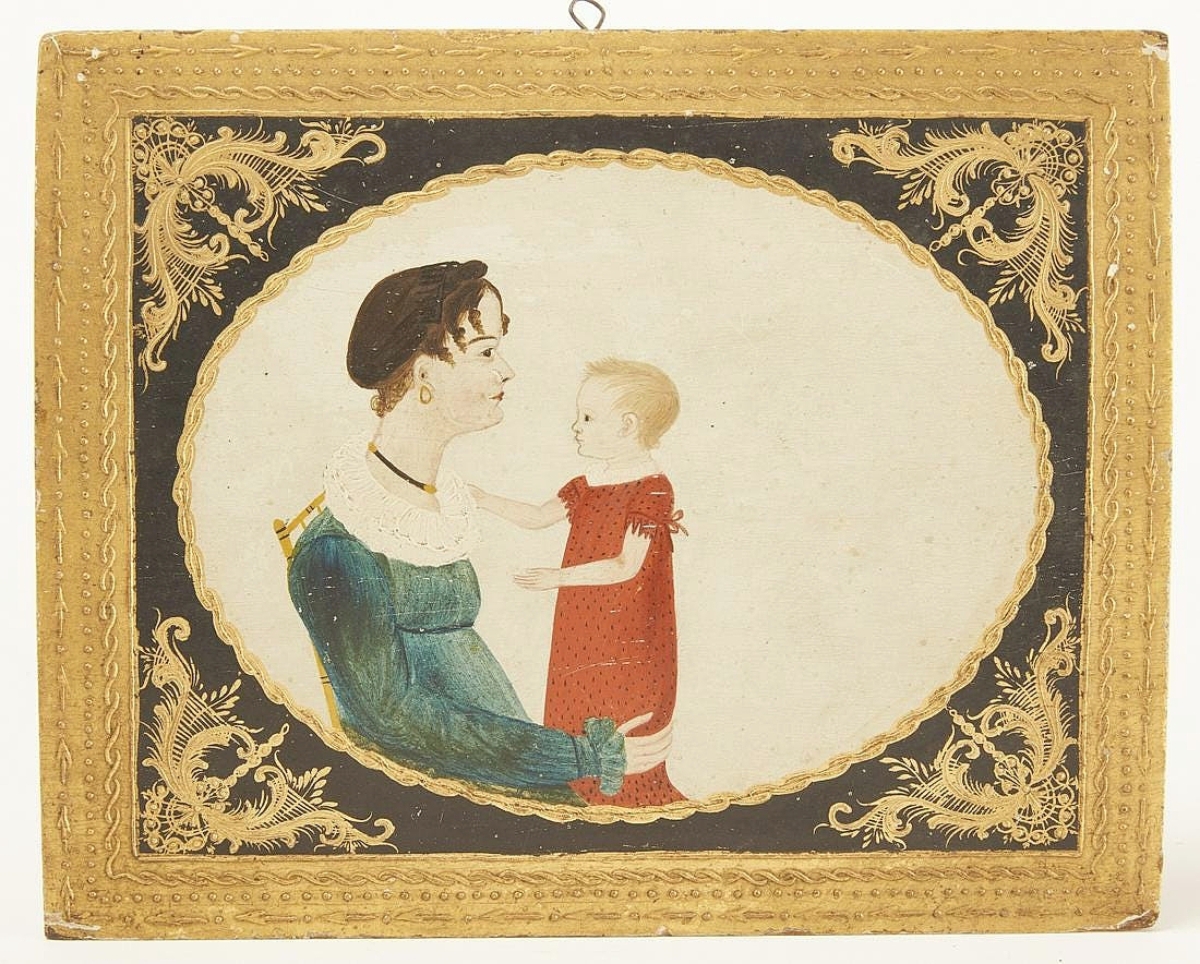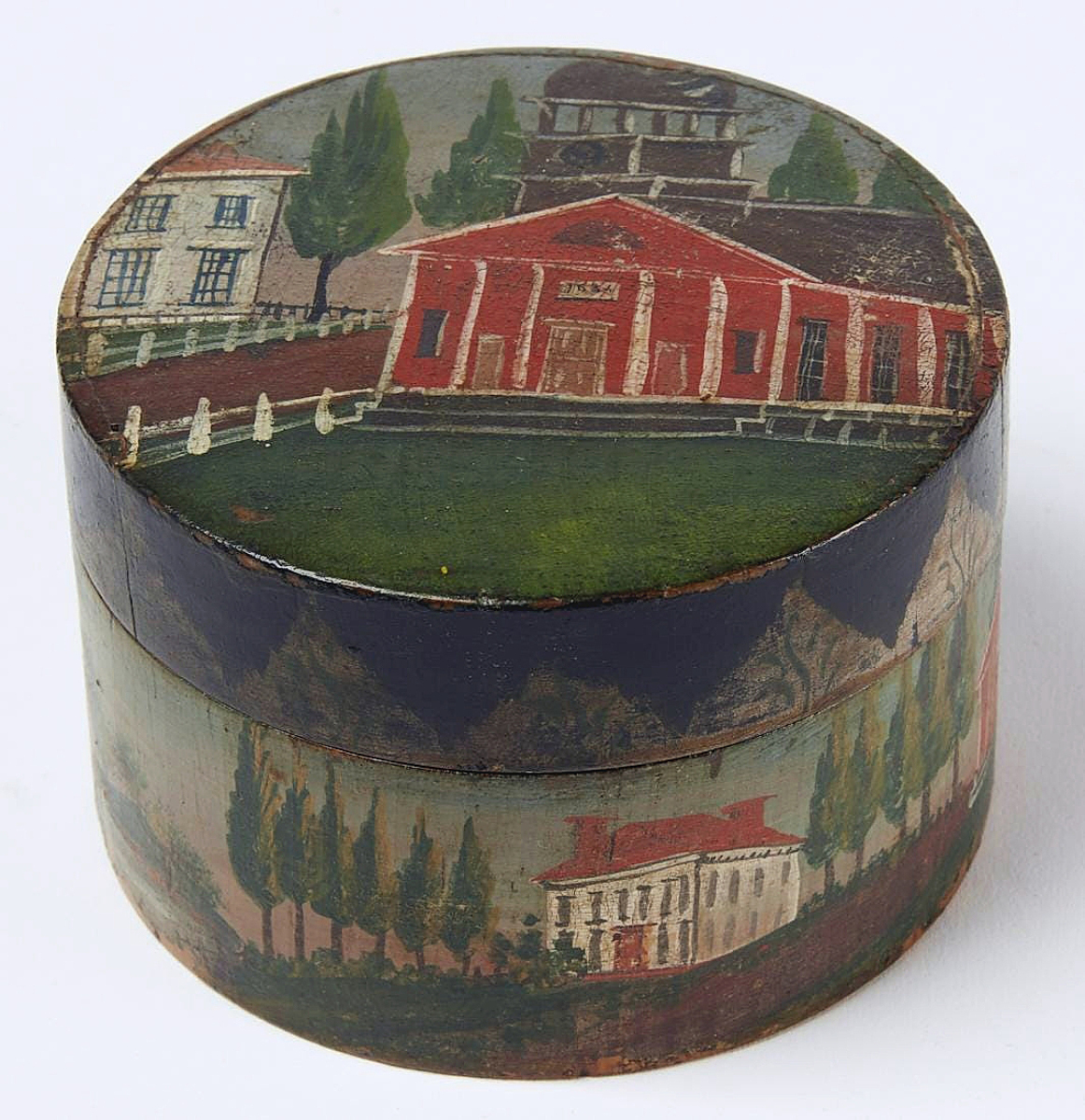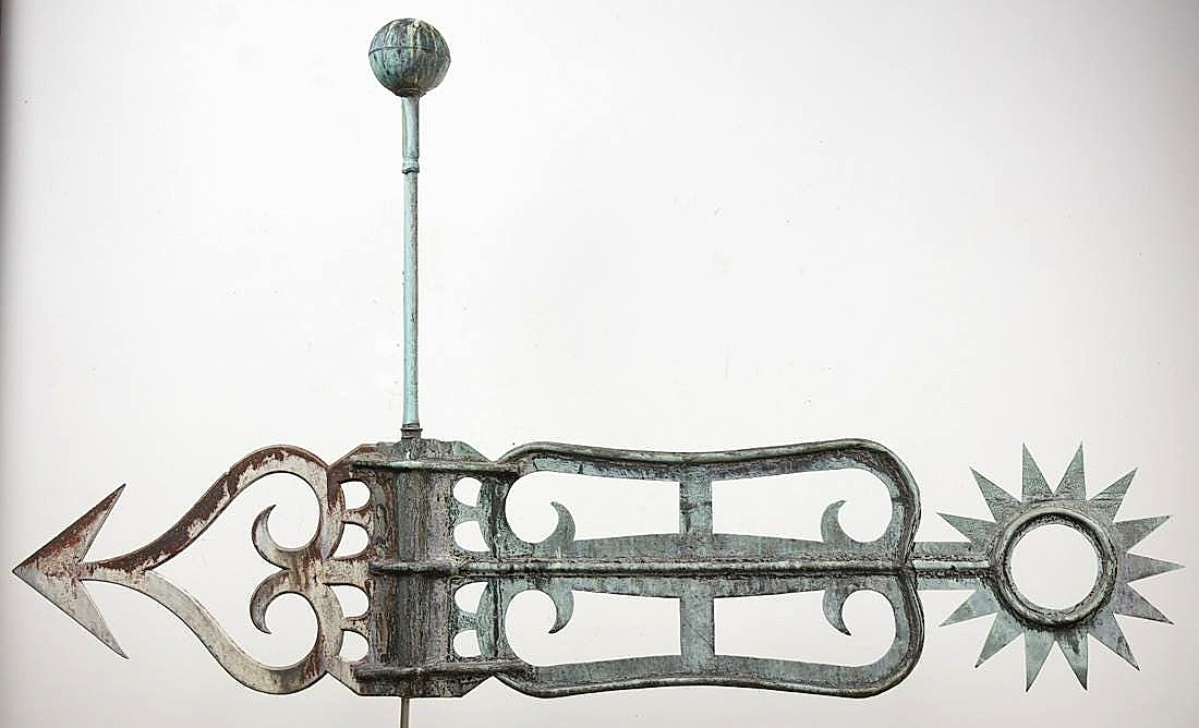
The sale’s top lot was a folk art needlework on paper that brought $49,200 to a collector. It was underbid by David Schorsch and came from the Sevatson collection. The banner reads “Ann Hall Her Work 1823.”
Review by Greg Smith, Additional Photos Courtesy New Haven Auctions
BRANFORD, CONN.- New Haven Auctions has moved. It didn’t take long for auctioneer Fred Giampietro’s firm, which ran its first sale in November, 2018, to outgrow its space on Peck Street. When an opportunity for more square feet opened up in Branford, just a stone’s throw from the beach, Giampietro seized the opportunity and took his operation eastward along the Connecticut coastline.
His April 10-11 sale, which offered a collection from dealer Bob Foley and the estate collection of dealer Nancy Sevatson, as well as others, was the best one yet for the firm when the total rang in at $1.39 million.
“We had a little over 6,000 registered bidders,” Giampietro said, “Very strong volume for a sale of specific material. People loved the new space, there’s so much right around here. It was fun seeing a lot of old friends that came by, we had a robust preview.”
The sale was led at $49,200 by a folk art needlework on paper featuring three women and a bird tree. It had come from the estate of Nancy Sevatson and lore said she had bought it at a small, uncataloged auction near her home in New Hampshire. The paper was linen-lined and tacked to a wood panel, a banner to the bottom of the work read “Ann Hall Her Work 1823.” It sold to a New York collector, underbid by Connecticut dealer David Schorsch.

Among the upper echelons of Bellamy carvings was this eagle that spanned 47½ inches. Giampietro said it had impeccable surface and it went out at $43,200. Foley collection.
Schorsch was more successful in buying back an 18-by-15-inch oil on canvas portrait of a boy by Benjamin Greenleaf for $5,160, a painting he had handled in 2008. “Greenleaf usually did reverse paintings on glass, so any work on canvas is very rare and it retained its original painted frame,” the dealer said. Schorsch related that the work originally came from the collection of Lloyd Goodrich (1897-1987), a historian of American painters who began working at the Whitney Museum of American Art in 1935 and became director in 1958.
The top lot from Foley’s collection came in at $43,200 for a 47½-inch-long carved eagle by John Haley Bellamy (1836-1914). “There are very few of the large Bellamy eagles, the really elongated ones,” Giampietro said. “The way Bellamy carved those, it’s extremely thin, I imagine they didn’t last. This was as perfect as you could find one, the surface was impeccable.”
Foley also supplied his personal collection of gameboards, which numbered to more than 50 examples. At the top was an early tavern checkerboard in a shaped pine frame with Queen Anne crest dating to circa 1800. It sold for $10,000. Leading up to the sale, Giampietro noted significant interest in the example, more than the others. “That piece was a testament that real antiques are really coming back. There’s a core group of buyers out there that still love early things, they understand the sensibility of early material and will step up and pay for that. If it was 1890s, it wouldn’t have brought that.”

With provenance to the collection of Don & Faye Walters, this portrait of a mother and child, paint on wood panel and measuring just 7½ by 9 inches, sold for $30,000.
Behind at $6,000 was a checkers board prized for its artful and geometric design. Circa 1900, the board was incised all over with opposing diagonal lines to form an overlaying pattern of diagonal squares. Taking $5,880 was a green-tinted Nine Men’s Morris and checkers gameboard that had provenance to dealers Jewett-Berdan as well as Sandy Jacobs. A graphic parcheesi/checkers board in a striking crackled blue paint with red, cream and green went on to produce $5,760. That board also had provenance to Jewett-Berdan.
“I’ve never seen anything quite like it,” Giampietro said of a paint-decorated trinket box, only 2¾ inches high, depicting the first meeting house in Bunker Hill. A period label to the underside of the lid stated that the box was made from components of the meeting house. “That town scene is extremely rare on a box,” Giampietro said. Bidders agreed as it went on to bring $22,800.
Also from Foley was an 82½-inch-long banner weathervane of copper and cast zinc displaying designs for a heart on the front end and a sunburst on the back. It was the first public offering of the vane as Foley purchased it from a seller who took it off a meetinghouse in Yarmouth, Maine. Giampietro attributed it to Howard and it sold for $20,625.

With an old label to the underside of the lid that stated the box was made with materials from the Bunker Hill meetinghouse, this diminutive painted lidded box, only 2¾ inches high, went out at $22,800. “I’ve never seen anything quite like it,” Giampietro said.
Attributed to Prior-Hamblin School artist George Hartwell were three portraits of the Hatch sisters, which remarkably remained together. The circa 1840 oil on artist board works sported at least two older frames and went on to bring $10,800. A portrait of a girl in a yellow dress by William Matthew Prior, oil on paperboard, 14 by 11 inches, sold for $5,880. A portrait of Hannah Boardman from the Prior-Hamblin School, 18 by nearly 14 inches, took $5,625, while a portrait of a young lady from the same school, 14 by 10 inches, sold for $5,280.
Rising above its high estimate at $30,000 was an original paint on wood panel featuring a mother and child, only 7½ by 9 inches. The painting was inside of an oval cartouche, embellished to the corners with a finely rendered gilt design. It had provenance to Don and Faye Walters. Walters was a curator at the Abby Aldrich Rockefeller Folk Art Museum at Colonial Williamsburg before he moved to Indiana and started dealing. “It’s one of the great masterpieces,” Giampietro said, “Don’s eye really influenced my interest in color and design. He is a great dealer. His sale was a landmark, the first time that a quality curated sale since the Stewart Gregory collection came to market. His collection would stand up against anyone’s.” The painting sold retail.
A marriage and mourning ring associated with Colonial Captain Edward Tyng, dated 1725 and 1730, went on to take $11,100 from a collector. The text inside read “E. Tyng E. Parnel Married 8 Jan. 1725 /6.” The firm believed it had been made by Boston goldsmith Edward Winslow, who apprenticed with Jeremiah Dummer. Elizabeth Parnell was Tyng’s first wife, and after her death he married Ann Waldo in 1731. Tyng was a leading American naval officer of the Colonial period as he engaged French and Spanish ships along the East Coast.

Bob Foley purchased this banner weathervane from the seller who took it off a meetinghouse in Yarmouth, Maine. In its debut to the market, Giampietro attributed the monumental vane to Howard. It measured 82½ inches long and brought $20,625.
At $15,000 was a Silas West tin Black man sign advertising Thompson Bros Clothiers, 52 inches high. “It was really the best example of a Silas West sign that I’ve ever seen,” Giampietro said. “They were used outdoors, and tin and paint are not good friends. It must have been used indoors, it didn’t have any kind of weathering on it.”
Taking $10,625 and $9,688 were two life-size cast iron standing deer from the late Nineteenth Century. Giampietro said they sold to the same retail buyer. Other garden ornaments included a cast iron dog attributed to the Gray Foundry in Poultney, Vt., circa 1890, which sold for $6,900. A cast concrete mastiff, late Nineteenth Century, sold for $4,875, while a 30-inch-long carved stone lion sold for $7,187.
Furniture was led with two shell-encrusted works from the Sevatson estate. At $15,625 was a tall clock, reportedly from Maine, that sold to a collector. It featured images of nautical stars, anchors and flowers. Selling to the trade was a chest of drawers with images of hearts, flowers and bursts, that went on to bring $13,750.
José Benito Ortega is said to be the last of the late Nineteenth Century santeros. He based himself in Mora, N.M., and would travel throughout the state and Colorado to make santos for houses of worship and meetinghouses. Attributed to the maker was a bulto carving of a saint together with two oxen on yoke that went on to bring $4,000. Another religious diorama, this one from northern Michigan and featuring five figures and two angels, went on to take $3,480.
New Haven Auctions’ next sale will feature live gallery bidding. The June auction will feature a New Haven estate, including fine art, Asian and Native American, together with a curated collection of modern and Pop culture material put together by dealer Michael Friedman.
All prices reported include buyer’s premium. For information, www.newhavenauctions.com or 475-234-5120.



































